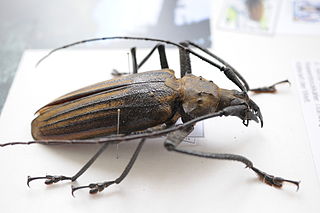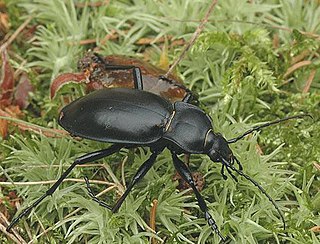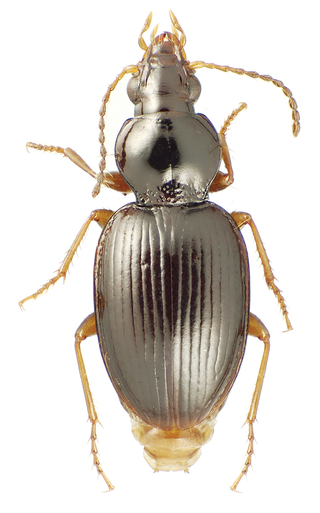
Xixuthrus is a small genus of long-horned beetles, found primarily on Pacific islands, including Indonesia, New Guinea, the Solomon Islands, and Fiji, and contains some of the largest living insect species, the giant Fijian long-horned beetle and the Taveuni beetle. These beetles have powerful jaws, and should be handled with care when alive. No scientists have yet seen a larva of this genus, although in Fiji, where three different species occur, the natives consider them to be a rare and special delicacy.

Utetheisa is a genus of tiger moths in the family Erebidae. The genus was first described by Jacob Hübner in 1819.

Carabus is a genus of beetles in the family Carabidae. The genus is highly diverse with 94 subgenera, 959 species and 2300 subspecies, thus is the largest genus in the subfamily Carabinae. The vast majority are native to the Palearctic, but 16 Nearctic species are also known. Carabus spp. are 12–50 mm (0.47–1.97 in) long, and most species are wingless and often very colourful. These are nocturnal, predatory beetles that feed on snails, earthworms, and caterpillars. Most Carabus species were thought to have inhabited the Eurasian forest, but the species' low dispersal abilities altered the distribution of lineages within the genus.

Mecodema is a genus of large flightless ground beetle (Carabidae) endemic to New Zealand. The genus is very diverse in comparison to the other three New Zealand genera within the subtribe Nothobroscina. Mecodema is geographically widespread across both the North and South Islands, as well as numerous offshore islands, including the Three Kings Is., Poor Knights Is., Aotea and Hauturu, Kapiti Is., Stephens Is., Stewart Is., Chatham Is., Snares Is.

Udara is a genus of butterflies in the family Lycaenidae. The species are found in the Indomalayan and the Australasian realms.

Agonum is a large genus of ground beetles in the subfamily Harpalinae, tribe Platynini. They are mid-sized to smallish beetles, typically with dark metallic hues – often reddish or bronze, but sometimes black, green etc.

Bembidion is the largest genus of beetles in the family Carabidae by number of species. All species are small and move very fast. Most of them live close to water. The genus has a biantitropical distribution, meaning they are found in both the Northern and Southern Hemispheres, but not in the tropics. In warmer regions it is substituted by closely related Tachys and other genera.

Xyletobius is a genus of beetles in the family Ptinidae.

Trogoderma is a genus of beetles in the family Dermestidae, the skin beetles. There are about 135 species worldwide.
Mirosternus is a genus of beetles in the family Ptinidae. There are at least 70 described species in Mirosternus.

Thomas Blackburn was an English-born Australian priest and entomologist who specialized in the study of beetles.

Mecyclothorax is a genus of beetles that contains over 400 described species or subspecies, mostly from the Hawaiian Islands, and Tahiti and Moorea, French Polynesia. Additional radiations have evolved in Queensland, Australia, New Guinea and New Caledonia. The genus has been divided into five subgenera: Eucyclothorax Liebherr 2018 of Australia, Qecyclothorax Liebherr 2018 of Queensland, Australia, Meonochilus Liebherr & Marris, 2009 of New Zealand, Phacothorax Jeannel 1944 of New Caledonia, and the more widely distributed subgenus Mecyclothorax Sharp 1903 [in Australia, the Sundas, New Zealand, the Society Islands, and Hawaii]. The adelphotaxon to Mecyclothorax is hypothesized to consist of the genera associated with Amblytelus Blackburn, also distributed in Australia, and therefore the evolutionary history of Mecyclothorax commenced in Australia.

Platynus is a genus of ground beetles in the family Carabidae. There are more than 180 described species in Platynus.

Psydrinae is a subfamily of beetles in the family Carabidae.

Tasmanitachoides is a genus of ground beetles in the family Carabidae, endemic to Australia. The beetles are very small, typically 1.5 to 3.0 mm. in length, and live in coarse sand or fine gravel along freshwater shorelines throughout Australia.
Mecyclothoraxaeneus is a species of ground beetle in the subfamily Psydrinae. It was described by Sharp in 1903.
Mecyclothorax molokaiae is a species of ground beetle in the subfamily Psydrinae. It was described by Sharp in 1903.

Ross Taylor Bell was an American entomologist with particular interest in the invertebrate natural history of Vermont, United States, and carabid beetles. Together with his wife, Joyce Rockenbach Bell, his work at the University of Vermont was largely taxonomic, where they described more than 75% of the rhysodine species known to science. Ross also wrote a number of seminal papers in his chosen field.

Eumolpini is a tribe of leaf beetles in the subfamily Eumolpinae. It is the largest tribe in the subfamily, with approximately 170 genera found worldwide. Members of the tribe almost always have a longitudinal median groove on the pygidium, which possibly helps to keep the elytra locked at rest. They also generally have a subglabrous body, as well as appendiculate pretarsal claws.

Trox oustaleti is an extinct species of hide beetle in the subfamily Troginae described from a fossil found in the Ypresian age Allenby Formation of British Columbia, Canada. Within the genus Trox, it is placed in the core subgenus Trox.


















